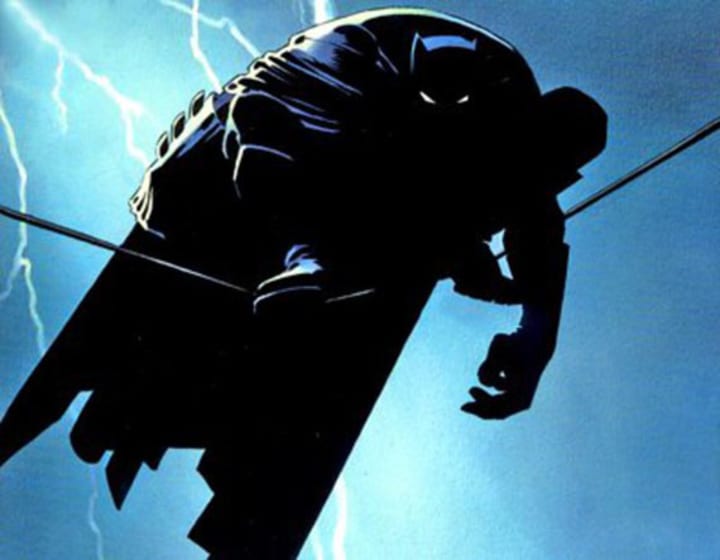The Strange and Grim World of Batman's Psyche
Frank Miller's Batman

Before 1986, Batman has been portrayed as a happy-go-lucky crime fighting hero. However, after 1986, Batman was revamped. In the newer, re-constructed version of Batman, he is given a broader range of emotions and depth. This idea of a grimmer, darker Batman, rose after Neal Adams left DC comics, thus having Dennis O’Neil step in and change the concept of Batman as a whole. “There Is No Hope in Crime Alley,” from Detective Comics #457 (March 1976) is an example, for the story, illustrated by Dick Giordano, showed a side of Batman no one had really experienced. It showed that Batman has a lingering and haunting memory of the street where his parents were murdered, and showed Batman’s obsession and psychological trauma that stayed with him all these years. In fact, Robert “Bob” Kane, the creator of Batman, wanted to paint Batman as a psychologically disturbed hero, thus, creating an alter ego for Bruce Wayne known as Batman. By the day, he is Bruce Wayne, a wealthy playboy who is the CEO of a wealthy enterprise; and by the night he is the masked vigilante. As Batman continued to help Gotham City, the mid 1980’s was a primetime for writers like Frank Miller to show Batman’s “darker side.” O’Neil even once said, “Look at Dracula, squint a bit, and you see the Batman,” hinting that Batman’s gothic and darker style somehow resembled that of Bram Stoker’s Dracula.
So Who Is the Dark Knight?

It’s hard to talk about Batman without talking about Frank Miller’s The Dark Knight Returns. The Dark Knight Returns digs deep into the psychology and trauma of Batman, and dives into the deep-rooted issues between him and his enemies. First and foremost, the Dark Knight is just a man, and he has no superpowers whatsoever. He is a fully functional member of society, and he has no sense of immortality like Superman or Wonder Woman. Batman has more going on mentally than he does physically. If we look at Batman’s abilities, they’re attainable by another human being, and he could be mortally wounded just like a regular person. Even if he may have a higher threshold for pain, he still has limits. Batman’s core mission is quite simple: to reduce crime and take out politically corrupt government officials. Unlike Don Quixote by Miguel de Cervantes Saavedr, which had the guide for the concept of chivalry, Batman doesn’t follow that rule. He has a moral code, of course — he will not take a life, nor will he use a gun.
“Not many details are known about Batman’s decision to retire, but it seems apparent that the transition was abrupt. Although still haunted by Jason’s death, Bruce was haunted to an ever greater degree by the decaying state of Gotham and by an inner voice, impossible to silence, that urged the return of Batman...”
What's Psychologically Wrong With Frank Miller's Batman?
In The Dark Knight Returns, Batman had retired the cape years earlier, but Gotham continues to be assaulted by the criminal classes, particularly the gang called “The Mutants.” A rehabilitated Harvey Dent and a catatonic Joker reawaken after Batman’s return. The Dark Knight Returns asks the question, “Do true heroes ever die?” However, describing the story in such grandiose terms also whitewashes people’s memory of the psychological turmoil of the Dark Knight in the narrative. In a 2003 interview, Frank Miller had said, “I long ago determined that a character like Batman can only be defined as a terrorist if his motto is striking terror.” Terrorism, by definition, would mean acts designed to cause terror, and although Batman does not target the civilian populace, one could say that he can definitely terrify them. In Miller’s The Dark Knight Returns, Batman’s motivation and his greatest weapon is fear. However, in the long run, fear only begets more fear. “Essentially a terrorist who just fights the right enemy.” Frank Miller had mentioned in an interview; “Mix of (super)heroism and ‘criminalism [that] is a culmination of Bat-man’s raison d'être.” Batman’s traits share several traits a terrorist would have, such as a need for a “secret identity,” the identities switching from Bruce Wayne to Batman. The Dark Knight also mentions that the crooks must be defeated or even humiliated. The questioning of Batman’s morals and ethics stagger, which is especially shown by Commissioner Gordon’s internal monologue in The Dark Knight Returns issue; the reference to Roosevelt describes how Gordon feels about the ground for Batman’s legitimization, due to Batman’s change from hero to terrorist.
I’m sure you’ve heard old fossils like me talk about Pearl Harbor, Yindel [...] Fact is, we mostly lie about it. We make it sound like we all leaped to our feet and went after the Axis on the spot. Hell, we were scared. Rumors were flying, we thought the Japanese had taken California. We didn’t even have an army, so there we were, lying in bed pulling the sheets over our heads – and there was Roosevelt, on the radio, strong and sure, taking fear and turning it into a fighting spirit. Almost overnight, we had our army. We won the war. Since then, presidents have come and gone, each one seeming smaller, weaker… the best of them like faint echoes of Roosevelt [...] A few years back, I was reading a news magazine – a lot of people with a lot of evidence said that Roosevelt knew Pearl was going to be attacked – and that he let it happen. Wasn’t proven. Things like that never are. I couldn’t stop thinking how horrible that would be… and how Pearl was what got us off our duffs in time to stop the Axis. But a lot of innocent men died. But we won the war. It bounced back and forth in my head until I realized I couldn’t judge it. It was too big. He was too big…”
Thus, Miller emphasizes the effect of Batman’s trauma eventually led to a great amount of fear, showing that Frank Miller’s The Dark Knight Returns is not just about the urban or ecological environments, but also depicts characters as ugly and deformed to give an outward appearance to the psychological turmoil bubbling beneath the surface of Batman and Gotham City.
About the Creator
Erina Liddle
Undergraduate college student in New York.






Comments
There are no comments for this story
Be the first to respond and start the conversation.